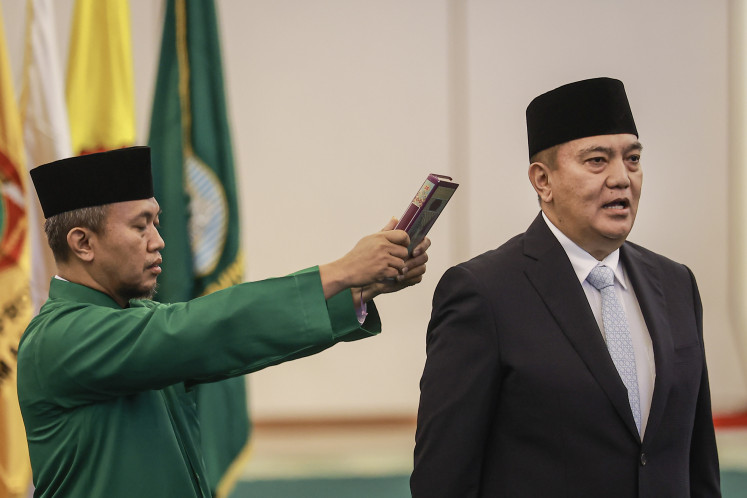Batik Day: Retracing the past, embracing the future
Timeless: Visitors admire a Cirebon-style batik cloth displayed at the Textile Museum in Central Jakarta
Change text size
Gift Premium Articles
to Anyone

Timeless: Visitors admire a Cirebon-style batik cloth displayed at the Textile Museum in Central Jakarta.(JP/Tertiani ZB Simanjuntak)
Ten years after Indonesian batik was recognized globally as a cultural heritage, collaborative efforts from the government and various communities to raise public awareness and to promote the inherent value of batik have shown satisfying results.
The most common ones are that batik has turned into a popular choice for workwear and a never-ending source of inspiration and material for fashion designers.
An organization of batik assessors has also been established to safeguard the original batik-making technique that was inscribed on the UNESCO list of Intangible Cultural Heritage of Humanity on Oct. 2, 2009. The date has been celebrated as National Batik Day since then.
But with all these achievements come new challenges.
In a public discussion held by the Textile Museum in Central Jakarta, three speakers raised several concerns that they said needed to be tackled to make batik even more relevant in this changing era.
The discussion held on Saturday was a part of the museum’s National Batik Day celebration.
Netherlands-based artist and batik blogger Sabine Bolk was conducting research on European influences in Javanese batik when she found some inconsistencies in different works of literature about Carolina Josephina von Franquemont (1816-1867), a German of Indonesian descent who is dubbed the Mother of Batik Belanda (Dutch Batik).
Bolk explained that Von Franquemont was said to have established the first atelier to produce batik in Java with a mix of Javanese and European motifs. She has also been credited for being the first to use wayang (shadow puppet) as a batik motif.
Her design style was nicknamed Prankemon and she created a unique green dye that was as colorfast as her signature.
She opened a batik workshop in Surabaya in 1840 but relocated five years later to an area near the Ungaran River in Semarang, Central Java. Von Franquemont reportedly lost her life in the eruption of Mount Ungaran. Other pieces of literature, however, claim she died on the same day of the eruption but the area in which she lived was not impacted by the calamity.
Further research by Bolk found a death notice in a Dutch newspaper by Von Franquemont’s brother announcing that she had died of an illness.
Not only are the stories surrounding her death confusing, but the authenticity of her work also needs further examination, she added.
“The practice of ateliers putting their signs on their works started in 1890, long after her death. But currently, there are 50 batik cloths attributed to her,” said Bolk.
Starting her research in June, Bolk found that Prankemon batik has completely different styles that raised doubts over whether they were made by the same atelier.
“This piece is attributed to Von Franquemont, but the similar one kept in Tropenmuseum [in Amsterdam] is attributed to Van Oosterom,” she said, pointing to the greenish batik on display next to the stage.
Catharina Carolina van Oosterom (born Philips) was another Batik Belanda atelier whose designs often included the motifs of cupid, cherubs, grapes and living creatures and were nicknamed Panastroman.
“All of the works of literature are European-centric, which mentioned Von Franquemont and Van Oosterom merely as batik entrepreneurs,” said Bolk, arguing that this contributed to the lack of records on the details of their works.
“Through the research, we expect to clear all the mistakes in the writing of the history of Indo-European influences in batik.”
Budi Darmawan of the Indonesian Batik Artisan and Entrepreneur Association (APPBI) said the popularity of batik had encouraged young people to learn more about the traditional craft and to contribute to its development as artisans.
He runs Rumah Batik Palbatu in South Jakarta, which involves young people with special needs, mainly deaf and speech-impaired people, whose works have become favorites among batik collectors.
“After they mastered batik-making and motifs, the most frequently asked question was, ‘What next?’” said Budi. “The next challenge for us is to establish business incubation for these young artisans.”
The association’s head for education, Agus Purwanto, meanwhile, underlined the importance of protecting regional batik craftmanship, such as the gentongan (batik colored in barrels) technique from Bangkalan in Madura and nitik (geometric dot pattern) technique from Yogyakarta.
As part of its Batik Day celebration, the Textile Museum is holding an exhibition of ancient and modern-styled batik until Oct. 31.









